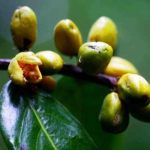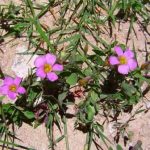TREE LIFE
March 2004
MASHONALAND CALENDAR
Tuesday 2nd March. Botanic Garden Walk. Meet Tom in the car park at 4.45 for 5 p.m. for a walk of general interest.
Sunday 21 March. Mr. Guy Holcroft has kindly agreed that we hold this outing on the Crest Breeders property which is off the Beatrice Road. This is a new venue for most of us. We will meet there at 9.30 a.m. Bring lunch and plenty of water.
Saturday 27th March. Mark will not be available to lead us this month so the walk is cancelled.
Tuesday 6th April. Botanic Garden Walk. Meet Tom in the car park at 4.45 for 5 pm.
MATABELELAND CALENDAR
Nothing has been arranged for March
DONATIONS
The Society is very pleased to be able to report two significant donations. Firstly, the late Shirley Dodds left the Society a legacy which was subsequently increased by her family. We are very grateful indeed for this generous gesture by both Shirley and her family. The second is a donation from Jim Hyde (my father) who has given the Society a generous donation. I have casually mentioned to him that the Society needed money but this was not a hint! At the moment the Society is considering how best to use this money; possibly just to strengthen our rather weak finances.
SUBSCRIPTIONS
After donations, we come to the very difficult question of subscriptions for the year beginning April 2004. I would request all members to read the following very carefully.
With official inflation running at 620% per annum and likely to remain high during the current year, this is bound to be a difficult question and the Committee has really struggled with this issue.
During the prior year, a major effort was made to get members to agree to receive Tree Life (by far our major cost) by email. I appreciate that this is not ideal in many ways as one is faced with either printing it out oneself or reading it on a screen.
However, I don’t think it would be an exaggeration to say that it has saved the Society. Currently, about half our members receive Tree Life electronically, which virtually costs us nothing. Considerable savings have also been achieved by hand deliveries and by cutting down on our reciprocal memberships.
For the rest, the main cost is the photocopying; not so much the paper nor the postage, although both have of course increased astronomically.
Because of this huge dichotomy in cost between the electronic and the non-electronic, we have decided upon a 2-tier subscription structure, as follows:-
Those receiving the electronic version of Tree Life: Z$5000
Those receiving the printed version: Z$10000
For those who receive the electronic version, the increase in subscription is 233%, far below the rate of inflation generally; a saving which the technology has permitted although at some inconvenience. The subs are then comparable with those charged by the Aloe Society and Birdlife.
I would strongly urge those members receiving hard copies to think about switching to email. This would be tremendously helpful to the Society.
For those who receive a hard copy the increase is 567%, slightly below published inflation. However, $10000 is still way below the true cost of producing Tree Life.
The Committee was very concerned that the burden of the higher subscription rate would fall on those who were least able to pay. We would hate to lose members as a result of these increases. Various ideas were discussed and rejected. In the end the following was decided.
We will ask those members who can afford to pay more to do so and their higher subscriptions will effectively support other members. This has produced a good response in the past and I’m hopeful it will do so again.
Those existing members, particularly those without email, who find the higher rate too much can simply pay what they can afford. Please do not feel too proud to do this the amount will be confidential and will be seen only by the Secretary and Treasurer. If anyone has any questions or comments on these changes please do not hesitate to contact me.
-Mark Hyde Chairman
UMWINDSIDALE: 18 JANUARY 2004
Our first outing of 2004 was to the lovely home of Norman and Eleanor Dickens on the Umwindsidale Road in the NE part of Harare. In my view, January is the loveliest season to be out in the bush everything is green and lush and the herbaceous flora is at its best. Of course, the greenness doesn’t last long as by February, shades of gold and brown will already be tinting the landscape.
The house is built on a small rocky rise with the Umwindsi River valley running nearby. Native trees surround the house and we were able to see numerous species within a few metres. The GPS gave our altitude as 1380 metres (4500 feet), just a tad lower than central Harare and I think that this had a slight impact on the plants we saw.
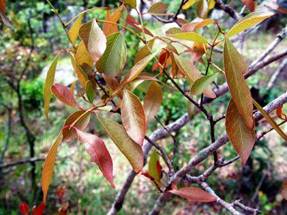
Pleurostylia africana. Photo: Rob Burrett. Source: Fora of Zimbabwe
The first species we examined was Pleurostylia africana (Northern Coffee-pear). Interestingly it was in flower with heads of small greenish flowers which were not very spectacular, but interesting to observe nonetheless. This species, although quite common, may be difficult to recognise; I always feel it is a bit anonymous, until you look closely. The leaves are leathery in texture (as many species of the Celastraceae are) and are opposite and hairless. A simple spot-character is that the branchlets are quite sharply 4-angled; this can be felt quite easily and also seen with a lens (or a pair of good eyes).
Albizia antunesiana (Purple-leaved Albizia) was present and we looked at it with care. Although trees of this species can have purplish leaves, it is usually the very juvenile specimens with show the most spectacular display of purple as they did on this occasion. The leaves are 2-pinnate with large leaflets and a gland on the petiole. Like all legumes, the leaves are arranged alternately but in this species the pinnae are opposite and so are the leaflets.
Burkea africana can look superficially similar. It too has alternate leaves and opposite pinnae but its leaflets are alternate. Furthermore, the rusty-brown hairs at the apex of the branches are usually a reliable way of recognising Burkea. The other species with the same arrangement of 2-pinnate leaves with alternate leaflets is Erythrophleum africanum (Ordeal Tree) but this is seldom a practical problem for us as it does not grow anywhere near Harare.
Both Pterocarpus rotundifolius subsp. rotundifolius (Round-leaved bloodwood) and Pterocarpus angolensis (Mukwa) were present. The genus has the distinctive fruit which is a flattened wing-like structure surrounding a central compartment containing the seed or seeds. The latin name of the genus is of course based on this. In the case of P. rotundifolius the fruit is quite smooth but in the mukwa the seed part is strongly armed with powerful bristles. Both trees have yellow pea-like flowers and are spectacular when flowering.
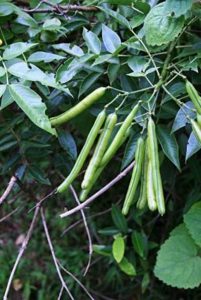
Senna septemtrionalis. Photo: Mark Hyde. Source: Flora of Zimbabwe
In the garden were specimens of an invading shrub or small tree, Senna septemtrionalis which Eleanor said had just arrived. This has typical yellow flowers of Senna and black cylindrical pods. In Zimbabwe it seems to prefer higher rainfall areas or wetter areas such as by streams. You see it most in the eastern districts where it occurs on forest edges; around Harare it is locally frequent either along watercourses (such as by the Mazowe at the Christon Bank reserve) or in disturbed places such as this.
Nearby was Garcinia buchananii, the Granite mangosteen. Said to have the most delicious fruit of any native tree, it is a small tree of rocky places. We folded the leaves to observe the yellow sap, a feature unique to this genus among Zimbabwean plants. Also present were Psorospermum febrifugum (the Christmas Berry), Strychnos spinosa (Spiny Monkey-orange), Diospyros lycioides (Red Star-apple) and of course many others, mostly common species.
Slightly more unusual was Catunaregam spinosa perhaps a sign that we were at a slightly lower altitude. This is one of the very few spiny Rubiaceae. The name of our species is about to change as it appears (per Meg Coates-Palgrave’s new book) that true C. spinosa occurs only in China. I gather that the new volume of Flora Zambesiaca which will contain the name is now out. We will publish details of any interesting changes in a future Tree Life.
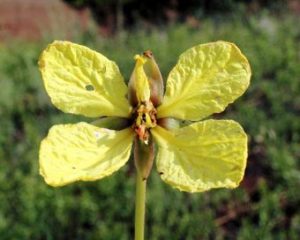
Tylosema fassoglense . Photo: Mark Hyde. Source: Flora of Zimbabwe
Having explored the garden, we set off out through the gate. Common here was the trailing species Tylosema fassoglense with its large yellow flowers. This is a Bauhinia relative, as its flowers, leaves and fruits strongly imply. Here also was our second interesting find of the day: Combretum apiculatum (Glossy Combretum). This is a very common tree in national terms, but it prefers lower altitudes and we don’t often see it close to Harare again a sign I think of the Dickens 1380m. The leaf is usually apiculate and has a typical glossy, brownish look as if it had been lightly varnished.
Our walk then took us round though a vlei and back up into some woodland where the third interesting find was made. This was not really a tree but more a weak woody climber Osyridicarpos schimperianus. The family is the Sandalwood family, Santalaceae, which with us contains the small tree Osyris lanceolatus and numerous species of a mainly herbaceous and taxonomically difficult genus called Thesium. The Osyridicarpos looks very like a Thesium. It is a local plant, perhaps overlooked, climbing on other woody plants and occurring in shady places, sometimes in woodland as here but also often in riverine vegetation.
By now, our stomachs were beginning their mid-day collective rumble and we returned to the house for a picnic lunch on the verandah. Our very great thanks go to Norman and Eleanor Dickens for hosting us. We would very much like to return some day.
–Mark Hyde
NOEL NUT NIXED BY GNAWING AGOUTIS By Alex Kirby BBC News Online environment correspondent
https://news.bbc.co.uk/2/low/science/nature/33
A familiar feature of Christmas in many British families, the Brazil nut, faces a threat from too-intensive harvesting. A report in the journal Science says populations of trees picked heavily over many years produce very few young trees, threatening the species’ future. The authors say it may be necessary to control the numbers of animals which rely on the nuts, including the agouti. But they say people should not stop eating Brazil nuts, because the trade helps to protect the Amazon rainforest.
Brazil nuts, strictly, are not nuts at all, but seeds, up to 25 of which are packed tightly inside a hard woody fruit the size of a large grapefruit.
They are the only seed crop traded internationally which have to be collected from the wild. Attempts to grow Brazils in artificial plantations have failed, because the trees produce fruit only in the forest.
No time to breed
They can reach 50 metres (164 feet) in height and 16.5 m (54 ft) in circumference at breast height.
The authors of the Science report studied 23 Brazil nut tree populations in Amazonia, in Brazil, Bolivia and Peru. They found populations extensively harvested over some decades were dominated by older trees, with very few younger trees in evidence, suggesting the normal regeneration cycle had been disrupted.
When they ran computer models to predict population trends for the next two centuries, the patterns they found were “highly consistent” with their observations.
The report’s main author is Dr Carlos Peres, a tropical conservation biologist in the School of Environmental Sciences at the University of East Anglia, UK.
He says: “The clear message is that current Brazil nut harvesting practices at many Amazonian forest sites are not sustainable in the long term.”
He believes his team’s observations and simulations show the dwindling numbers of older trees in persistently over-exploited areas are not being adequately replaced by young trees.
The trade is significant, with more than 45,000 tonnes collected annually in Brazil alone, worth more than $33m.
The team recommends close monitoring and careful management of the trees to avoid an eventual collapse of the industry. It suggests a possible annual nut quota, a replanting scheme using seedlings grown in nurseries, and a rotation system to leave areas unharvested from time to time.
Secretive chewers
Perhaps controversially, it says it may be necessary to control seed-eating animals and large herbivores, to give the seeds the best chance of germinating. Possible candidates include tapirs, brocket deer and agoutis, large rodents which play a crucial role in sustaining the Brazil nut trees.
Dr Peres told BBC News Online: “Most of the fruit lie where they fall on the forest floor until they’re attacked by termites or fungi.
“But agoutis will gnaw them open – it can take them the best part of an hour – and then bury the seeds to eat later. One agouti can scatter and bury a lot of seeds, and eventually it will eat most of them, but not all. So they’re very important seed dispersers – but also seed predators.
“If you shoot a few agoutis, you’ll get more seedlings. We’ve got another study, using agoutis with radio collars, to learn more about their role.
What we don’t want is for people to conclude that they should stop eating Brazil nuts. They provide an income for millions of people in Amazonia, and stopping the trade would undermine a relatively benign use of large tracts of the forest. That would leave people without any income and open the forest up for more damaging uses like ranching and logging.”
From Doug and Klara Ball in Kuwait
THE DISCOVERY OF WILD BOTTLE GOURD
(LAGENARIA SICERARIA)
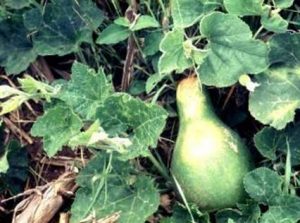
LAGENARIA SICERARIA. Photo: Plantz Africa
is the well-known and pantropically distributed bottle gourd. In Zimbabwe, this domesticated cucurbit is grown for its edible fruits as well as for containers and musical instruments. In the major market places in Harare, such as Mbare, dried gourds can be found for sale in many varying shapes and sizes from the huge kettle drum variety, which is used to amplify the musical sounds of the mbira or thumb piano, to very small bilobal gourds used for the medicinal potions carried by local nangas or traditional medical practitioners. The young, green, non-bitter fruits of various cultivated types can be found for sale as vegetables. In the southwestern city of Bulawayo, a popular cooking vegetable is a warted form known as makomane.
Having an abiding interest in the bottle gourd, I had long been aware of the questions concerning its origins. This species had never been documented in the wild, and I secretly imagined myself to be the one who might one day find its ancestral relatives in the wilds of Africa. At least so I dreamed as I made my plans in 1989 to move back to Africa after an absence of 12 years, permanently I then believed, to study the native cucurbits of Zimbabwe and southern Africa.
During the 1990s, my husband, Anthon, and I made several cucurbit field trips throughout Zimbabwe. In our travels we found the two wild species of Lagenaria that occur in Zimbabwe, L. sphaerica and L. breviflora, both of which have round tennis-ball to softball-sized fruits. In March 1992, we were in the Gonarezhou National Park on Zimbabwe’s eastern border with Mozambique searching for another native cucurbit, the gemsbok cucumber (Acanthosicyos naudinianus). The Gonorezhou lies in an arid area of Zimbabwe in the lowveld, where the vegetation is dominated by monster baobab trees, acacias, and mopane woodland. During the early 1990s, it was a very remote and wild area of the country with no villages or evidence of human habitation. Here amongst the mopane trees, we observed some small round gourds hanging high up in the branches of a dormant leafless tree on the bank of a seasonal stream. The vine itself had long since died back, but the gourds remained attached by their peduncles, still a mottled green colour and continuing to dry. The shape of the fruits and the dry region in which the plant occurred led me to believe that this was L. sphaerica. The other wild species, L. breviflora, is only known to occur in areas of high rainfall. Thanks to Anthon’s esteemed tree-climbing abilities, he was able to collect several of the gourds which we kept for later study. It was in fact years later, in 1995, when I decided to plant some of the seeds in our garden in Bulawayo. By then, the gourds were completely dried and I had noticed that the thin rind had been slowly disintegrating. The seeds were somewhat similar in appearance to those of L. sphaerica. It came as a great surprise, therefore, to note that the maturing plant did not fit the description of L. sphaerica. The stems and leaves were softly tomentose and the leaves had that very familiar musky odour of bottle gourds foliage. The flowers were solitary and night-blooming, and together with the monoecious habit, all factors seemed to suggest that it was not L. sphaerica as originally assumed, but instead, it appeared to be L. siceraria or perhaps a hybrid of the two species. At the end of the growing season, the vines died back; they did not reappear the next season. Here was another clue to the plant’s identity this was an annual with fibrous roots, whereas L. sphaerica and L. breviflora are perennials with large sausage-shaped underground roots. All indications were starting to suggest that this chance discovery could turn out to be a very important find: that a wild L. siceraria, presumably related to the wild ancestor of domesticated bottle gourd, had been found in Africa.
Subsequent planting of seeds of this collection in Bulawayo yielded uniform-sized 7 – 7.4 cm diameter, round gourds with mottled green and white rinds. The pepos remained hanging on the dried vines for up to two years before they ripened completely, turning light brown and eventually falling off the vine. The seeds measured 10 – 13 mm long, 4 – 5 mm wide, and 3 mm thick, with the latter dimension giving them a fat appearance relative to other Lagenaria seeds. Seeds saved over a period of several years remained viable. However, in contrast to the durable rind of most bottle gourds, the dried rind of my fruits was very thin and easily cracked.
By 2001, the political and economic circumstances in Zimbabwe had become of such a nature that it was necessary for us to leave the country. I brought my precious gourd seeds along in the few pieces of luggage that we were able to take with us. Soon after arrival in USA, I contacted Deena Decker-Walters and sent her some seeds of our Zimbabwe gourd discovery. With her experience in DNA testing procedures, she was able to confirm that the Zimbabwe gourd is an ancient type of L. siceraria. Next year we hope to go back to Africa to look for additional populations of this potentially historical wild bottle gourd. It is exciting to be a part of the continuing research on what could likely be considered man’s best friend of the plant world.
-Mary H Wilkins
THE GENETIC EVIDENCE
Mary sent me seeds of her wild Zimbabwe gourd in 2001. Naturally I was curious, but I was hip-deep in another cucurbit project. Almost two years went by before I, with help from Sang-Min Chung and Jack Staub, could subject her gourd to genetic analyses. Specifically, we used random amplified polymorphic DNA (RAPD) markers and chloroplast sequence analysis to see whether or not Mary’s gourd was Lagenaria siceraria, L. sphaerica, or a hybrid of the two species.
The results were pleasantly surprising. Not only did the Zimbabwe germplasm predominately exhibit a L. siceraria type of genetic profile, it also contained unique markers, which suggest that Mary’s collection is from a lineage of wild gourds that has itself experienced evolutionary change since the time of bottle gourd domestication. What a discovery! Now, if we can only find more populations!
-DDW. Reprinted with permission of ‘The Cucurbit Network’.
WONDROUS WEEDS
Newsweek February 9, 2004
Most weeds are noxious, unwanted plants awaiting a whacking. But a Danish biotech company has adapted one, the thale-cress plant, to help save lives. Scientists at Aresa Biodetection in Copenhagen have genetically modified the plant so that it changes from its normal green hue to red when its roots touch nitrogen dioxide, a gas that seeps out of buried land mines and unexploded ordnance.
Many of these explosives can remain active for over 50 years, emitting nitrogen dioxide all the while.
Don’t laugh at the idea of a demining plant: this invention could well take root. After all, demining groups need all the help they can get as an estimated 50 million unexploded land mines are scattered in 70 countries, and each year, they maim up to 20 000 people. Getting rid of the mines is tedious, painstaking work: a good deminer will clear just two square meters in a day.
The colour-changing weed won’t be a silver bullet. For one, a path will still need to be cleared through a minefield so that thale-cress seeds can be scattered over the land. (The seeds take three to six weeks to grow.) And removing the mines from the ground will still take time and hard work. But the superweed, expected to be used regularly within two years, does present a cost-effective alternative to the most common detection methods currently available humans with metal detectors and mine-sniffing dogs. And since these plants have been engineered so they can’t reproduce, there’s no danger of their overrunning fields, either.
-Clint Witchalls.
THE LIME TREE OF FREIBURG
In the main square of the town of Freiburg in Switzerland stands a Lime tree planted in 1476. The tree, encircled by a low fence, is surrounded by lawn and flowering plants a centuries-old shrine in the heart of this once quiet town, but now, with the passing years, in the midst of busy traffic.
A plaque on the tree-trunk reads:
MURTENLINDE 1476
Freiburg, an old-world town dating from the 12th century, is built on a hilly site. Worn stone steps and narrow cobbled streets leading from the Square to the upper parts of the town have stood like this for centuries. The fine old Cathedral of St. Nikolaus adjoins the Square as does also the Rathaus, both dating from the early 16th century.
How come this ancient Lime tree in the central Square of Freiburg?
In 1476 the French Duke of Burgundy, known as Charles the Bold, was defeated by the Swiss at Murten. If you have read Sir Walter Scott’s Quentin Durward, you will know of the activities of this ambitious Duke who aspired to the throne of France and sought to add Switzerland to his vast French estates.
An army division of young men from the town of Freiburg fought in the battle of Murten alongside their fellows from other parts of Switzerland. The battle was decisive. Charles the Bold was defeated. Jubilantly the Commander of the Freiburg Division chose a young soldier to carry the news of the victory to the eagerly-waiting people in Freiburg. The runner arrived out of breath after his strenuous journey and was only able to gasp Victory! before he collapsed and died.
In the young soldier’s hat there was a twig of Tilia the Lime tree. History relates that it was this twig, carried by the messenger of victory, that was planted and which has now grown into the beautiful Lime tree which still stands in the central Square of Freiburg, bursting into leaf each spring. The tree is carefully tended by the townsfolk who believe that it protects their town.
Note on Tilia.
Tilia, the Lime or Linden tree is common in Europe. It is a tree bearing clusters of fragrant yellowish or whitish flowers freely visited by bees for the copious nectar.
It is strange how this tale of the Lime tree at Freiburg recalls a similar incident of past history. In 490 BC a great battle was fought in ancient Greece on the plain of Marathon, 22 miles from Athens. The Persians had invaded Greece and were encamped on the seashore. There they were attacked and routed by a Greek army composed chiefly of Athenians. After the battle, the Commander Miliades selected a young soldier to take the news of victory to Athens. Pheidippides then ran the distance at top speed and fell dead after delivering his message.
Since 1896 the modern world of athletics has applied the term Marathon to a race on foot over roughly the same distance as that traversed by the Greek runner after the battle of Marathon. The chief Marathon race in these days forms part of the Olympic Games.
Gertrude Ordman Trees in South Africa April-June 1970
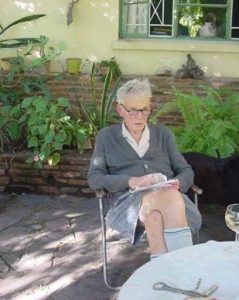
We would like to wish Mr. Bob Drummond a very happy
80th birthday on 27th February.
CONGRATULATIONS BOB
MARK HYDE CHAIRMAN


